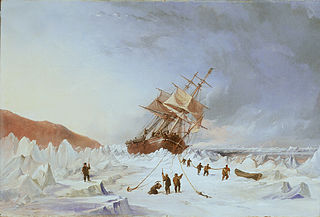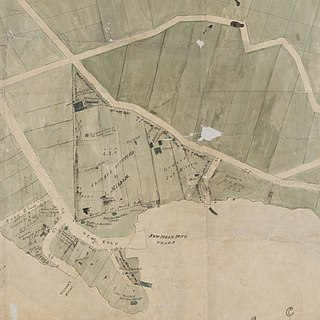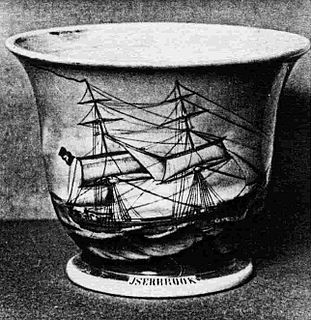
The First Fleet was the 11 ships that departed from Portsmouth, England, on 13 May 1787 to found the penal colony that became the first European settlement in Australia. The Fleet consisted of two Royal Navy vessels, three store ships and six convict transports, carrying between 1,000 and 1,500 convicts, marines, seamen, civil officers and free people, and a large quantity of stores. From England, the Fleet sailed southwest to Rio de Janeiro, then east to Cape Town and via the Great Southern Ocean to Botany Bay, arriving over the period of 18 to 20 January 1788, taking 250 to 252 days from departure to final arrival.

Marco Polo was a three-masted wooden clipper ship, launched in 1851 at Saint John, New Brunswick. She was named after Venetian traveler Marco Polo. The ship carried emigrants and passengers to Australia and was the first vessel to make the trip in under six months. Later in her career, the ship was used as a cargo ship before being run aground off Cavendish, Prince Edward Island in 1883.

Twofold Bay is an open oceanic embayment that is located in the South Coast region of New South Wales, Australia.
The General Screw Steam Shipping Company was a British company established in 1848 by James Laming, who had for about 30 years owned sailing ships travelling between England and the Netherlands.

HMS Assistance was an Arctic discovery barque of the Royal Navy, and the sixth vessel to carry the name. She began her life in 1834 as the Indian-built merchant vessel Acorn. Her name was changed to Baboo and under that name she transported coolies between Mauritius and India, and immigrants to South Australia. The Royal Navy purchased her in 1850. Assistance participated in two Arctic expeditions before her crew abandoned her in the ice in 1854.

Surry, also known as Surrey, had an especially long career transporting convicts to Australia. In 11 voyages, the most of any convict transport, she brought 2,177 convicts, male and female, and so became one of the best-known of the vessels that visited Australia. In all, she lost 51 men and one woman during her various passages, 46 of the men dying during her first and most notorious voyage in 1814 when she was under the command of James Patterson.
The Looshtauk was an Irish emigrant ship, captained by John M. Thain, sailing from the Port of Liverpool to the Port of Quebec on April 17, 1847. 462 passengers boarded at Liverpool. Typhus was caught by two male passengers in Liverpool and broke out during the crossing. Scarlet fever also erupted.

SS Persic was an ocean liner of the White Star Line, built by Harland and Wolff in 1899. She was one of the five 'Jubilee Class' ships built specifically to service the Liverpool–Cape Town–Sydney route. The voyage took six weeks.
The typhus epidemic of 1847 was an outbreak of epidemic typhus caused by a massive Irish emigration in 1847, during the Great Famine, aboard crowded and disease-ridden "coffin ships".
The Beejapore was a 1,676 ton full-rigged clipper built at Saint John, New Brunswick in 1851.
Victory was built by Fenwick & Co, Sunderland in 1847 and owned by Willis, Gunn and Co and later owned by Wilson and Cook. She was a 578- or 579-ton barque that brought some of the first immigrants from England to Dunedin in July 1848. She also called at Wellington, New Zealand, in August 1848. There was an advertisement that gave her weight as 700 tons, but, given that her captain in 1851 was Mullens, it was unlikely to be another ship.

Iserbrook was a general cargo and passenger brig built in 1853 at Hamburg (Germany) for Joh. Ces. Godeffroy & Sohn. It spent over twenty years as an immigrant and general cargo vessel, transporting passengers from Hamburg to South Africa, Australia and Chile, as well as servicing its owner's business in the Pacific. Later on, the vessel came into Australian possession and continued sailing for the Pacific trade. In 1878 it caught fire and was sunk the same year. At last, it was re-floated and used as a transport barge and hulk in Sydney until it sunk again and finally was blown up.
Whitby was a three-masted, square-rigger launched in 1837 and later re-rigged as a barque. She was registered in London, and made voyages to India, British Guiana, Australia, and New Zealand. In 1841 Whitby, Arrow, and Will Watch carried surveyors and labourers for the New Zealand Company to prepare plots for the first settlers. Whitby was wrecked at Kaipara Harbour in April 1853.
The Pestonjee Bomanjee was a wooden sailing ship built in 1834 by James Lang of Dumbarton, Scotland. She was a three-masted wooden barque of 595 tons, 130 feet in length, 31.5 feet in breadth, first owned by John Miller Jnr and Company, Glasgow. Her last-known registered owner in 1861 was Patrick Keith & George Ross, Calcutta.
Asia was a merchant ship launched at Calcutta in 1815 for Charles Hackett. She made four voyages transporting convicts from Great Britain to Australia, and two voyages under charter to the British East India Company (EIC) between 1826-1830. She was hulked or broken up c.1860.
Bussorah Merchant was a merchant ship built at Calcutta in 1818. She made three voyages transporting convicts from England and Ireland to Australia and later carried emigrants and other passengers to Australia.
Eliza was a merchant ship built in Calcutta, British India, in 1811. She made two voyages transporting convicts from Calcutta to Australia but wrecked in 1815 on her way home from her second voyage.

The New Zealand Company was a 19th-century English company that played a key role in the colonisation of New Zealand. The company was formed to carry out the principles of systematic colonisation devised by Edward Gibbon Wakefield, who envisaged the creation of a new-model English society in the southern hemisphere. Under Wakefield's model, the colony would attract capitalists who would then have a ready supply of labour—migrant labourers who could not initially afford to be property owners, but who would have the expectation of one day buying land with their savings.
Georgiana was built in British India c.1819, probably in late 1818. She traded in the Far East for most of her career, and between India and London. She made one voyage under charter to the British East India Company (EIC). She also brought immigrants to Australia. She was last listed in Lloyd's Register in 1844.
Dorset was a merchant ship built by William Porter at Liverpool, England in 1835. She made a number of voyages around the south east coast of Australia with cargo and undertook one voyage transporting 9 male convicts to New South Wales.











